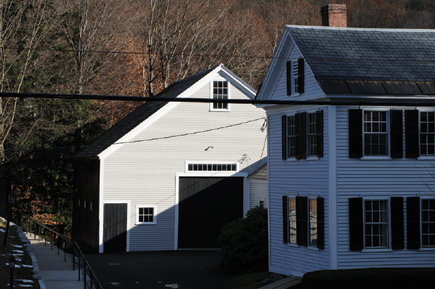Nikon’s D300; 12.3Mp, Live View, Picture Control & More Page 2
Light And Color Control
To test out the newest features on the D300 I spent a few weeks shooting it
under various lighting conditions and settings. I was impressed with what Nikon
calls Scene Recognition System, a somewhat cryptic name that makes Matrix metering
a even more accurate pattern choice than in the past. In one setup shot I deliberately
chose a high-contrast scene that in the past would call for spot +1 metering,
that is, reading the bright highlight and using +1 exposure compensation to
ensure that neither the shadows go too deep nor the highlight too gray. I shot
one exposure by carefully metering with the spot +1 option and then set it on
Matrix and shot without locking or making any changes. The Matrix option nailed
the exposure without intrusion on my part.
Another intriguing control is the new "Active" D-Lighting. I had
used this item in the Nikon Retouch menu in the past, which opened up shadow
areas in a contrasty scene. This was an après-exposure change done right
in the camera. Now you can play with the tonal curve before exposure, given
you recognize the lighting condition that might have given you trouble in the
past. There are three Active options--low, medium, and high--and knowing
which one to choose will be a matter of experience. This is a clever in camera
control that wrestles with the high-contrast bugaboo suffered by all digital
sensors, and does give you a leg up on controlling high-contrast scenes. It
worked particularly well on bright winter days and helped, but did not totally
eliminate contrast problems. This is something you have to play with to get
a feel for, as degree of contrast will determine how well it solves the problem.
And you do have to stay in Matrix pattern for it to work.
Live View - Tripod Mode |
Dim Lighting |
||
 |
 |
||
|
|
The fill flash, while not being more powerful than most, certainly plays well
with the Scene Recognition setup. My usual fill procedure is to lock exposure
on the brighter background area and then use fill for the foreground, controlling
flash output through either flash exposure compensation or narrowing aperture
in Aperture-Priority mode, or both. While I followed this setup for control,
I found that working in Matrix and Program, of all things, worked quite well
to yield a balance between brighter background and illuminated foreground--quite
impressive.
In all, the exposure and focusing system in this camera is quite uncanny. In
the past makers have always hinted at total exposure control, and that their
evaluative, matrix, or whatever system delivered the goods in all types of lighting
conditions. Exposure should never be taken for granted, and there are numerous
lighting conditions that can trip us all up, but I have to say that the D300
gets pretty close to figuring out many of the lighting scenarios that would
have caused many more problems in the past.
Active D-Lighting |
|
 |
|
 |
|
|
This is a camera that you can program to deliver just the color (and contrast, etc.) you want for every subject and scene. Like most cameras you can choose some presets that reflect the opinion of the maker as to what constitutes Vivid, Standard, etc. And like other cameras you can insert your take on things by going into the Menu and creating nuances of sharpness, saturation, brightness, contrast, and even hue variations for the presets. But the D300 takes it all a bit further. In the Shooting Menu choose "Manage Picture Control," then "Save/Edit." You can then play with all the parameters as you will, which of course will be subject to testing to ensure it's where you want it to be. Then you can actually rename the setup as "Wintertime" or "Fall Foliage" or "Portraits" or whatever. Note that the default naming is an appended number to whatever Picture Control preset you choose, but you can override, say, "Vivid-02" with more recognizable and usable appellations with the alphanumeric keypad and toggle control. This is a bit time-consuming, but once set up it should serve you well. Note that you can also do this with Monochrome/Filter combinations.
- Log in or register to post comments

































